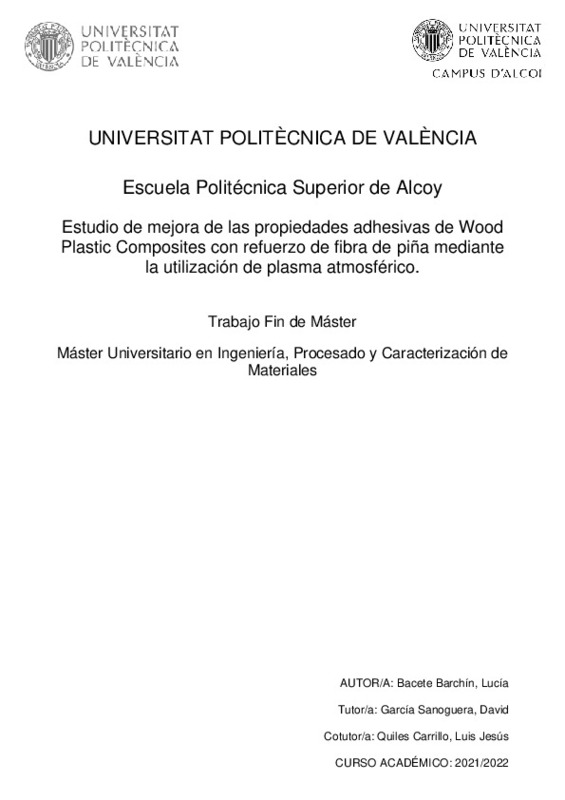|
Resumen:
|
[ES] El trabajo tiene como objetivo principal la optimización del tratamiento con plasma atmosférico sobre un compuesto de origen renovable (WPC) constituido por BioHDPE a partir de caña de azúcar y fibras de piña proveniente ...[+]
[ES] El trabajo tiene como objetivo principal la optimización del tratamiento con plasma atmosférico sobre un compuesto de origen renovable (WPC) constituido por BioHDPE a partir de caña de azúcar y fibras de piña proveniente del pino común mediterráneo (Pinus Halepensis). Se utilizarán tres tipos de compuestos con concentraciones diferentes de fibra de piña (10, 20 y 30% en peso). Se evaluará para cada uno de los compuestos el efecto de las variables de tratamiento de plasma atmosférico, en términos de velocidad de aplicación y distancia superficie tobera. Se determinará la energía superficial de cada una de las muestras tratadas mediante el método Owens Wends a partir de la medición de los ángulos de contacto con 4 líquidos diferentes. Del mismo modo, se analizará el efecto del tratamiento sobre la rugosidad superficial de las muestras, con el objeto de conocer los mecanismos de actuación del plasma sobre el WPC. Además, se analizará el efecto de la recuperación hidrofóbica mediante ensayos de envejecimiento en condiciones de almacenamiento controlado (HR y Tª). Para finalizar se validará la mejora de propiedades adhesivas mediante la determinación de la resistencia de las uniones adhesivas para las condiciones óptimas de tratamiento con plasma.
[-]
[EN] The use of wood plastic composites (WPC) is growing rapidly in recent years accompanied by the use of plastics of renewable origin, with the aim of reducing the waste generated by conventional plastics, replacing their ...[+]
[EN] The use of wood plastic composites (WPC) is growing rapidly in recent years accompanied by the use of plastics of renewable origin, with the aim of reducing the waste generated by conventional plastics, replacing their petrochemical nature and thus making more sustainable materials and less harmful to the environment. In this study, several composites have been developed, formed by a biopolyethylene matrix (BioHDPE) with a pinecone fiber content of 5%, 10% and 20%, together with polyethylenegraft-maleic anhydride (PE-g-MA) as a compatibilizer to improve the interaction between the two components. These materials have been treated with atmospheric plasma at different distances (6 mm and 10 mm) in order to improve the adhesive properties of the
material. The variation of the contact angle and the variation of the surface energy before and after the treatment have been analyzed. Also, the aging of the different materials was studied after treatment for five days stored under unfavorable temperature and humidity conditions, in order to quantify their hydrophobic recovery. Finally, once the different materials had been bonded with the adhesive, the improvement of the adhesive properties after surface treatment was analyzed by means of a shear test. The results show an improvement in wettability and an increase in surface energy after plasma treatment. They also show a rapid hydrophobic recovery after several hours of storage of the treated materials, although the recovery is slower the more pinecone fiber loading
there is. Finally, the maximum force supported by the adhesive is higher the more aggressive the surface treatment of the substrate, showing significant differences between treated and untreated samples.
[-]
[CA] L’ús de “wood plastic composites” (WPC) està creixent ràpidament en els darrers anys acompanyat de l'ús de plàstics d'origen renovable, amb l'objectiu de disminuir els residus generats pels plàstics convencionals, ...[+]
[CA] L’ús de “wood plastic composites” (WPC) està creixent ràpidament en els darrers anys acompanyat de l'ús de plàstics d'origen renovable, amb l'objectiu de disminuir els residus generats pels plàstics convencionals, substituint-ne la naturalesa petroquímica i així fer materials més sostenibles i menys perjudicials per al medi ambient. En aquest estudi s'han desenvolupat diversos compostos, formats per una matriu de biopolietilè (Bio-HDPE) amb una càrrega de fibra de pinya del 5%, 10% i 20%, juntament amb polietilen-graft-maleic anhídrid (PE-g- MA) com a compatibilitzant per millorar la interacció entre els dos components. Aquests materials han estat tractats amb plasma atmosfèric a diferents distàncies (6 mm i 10 mm) amb l'objectiu de millorar les propietats adhesives del material. S’ha analitzat la variació de l’angle de contacte i la variació de l’energia superficial abans i després del tractament. També s'ha estudiat l'envelliment dels diferents materials després del tractament durant cinc dies emmagatzemats baix unes condicions de temperatura i humitat desfavorables, per quantificar-ne la
recuperació hidrofòbica. Per acabar, una vegada enganxats els diferents materials amb l'adhesiu, mitjançant un assaig de cisalla s'ha analitzat la millora de les propietats adhesives després del tractament superficial. Els resultats mostren una millora de la humectabilitat i un augment de l’energia superficial després del tractament amb plasma. També mostren una recuperació hidrofòbica molt ràpida després de diverses hores d'emmagatzematge dels materials tractats, encara que la recuperació és més lenta com més càrrega de fibra de pinya hi ha. I, finalment, la força màxima que suporta l'adhesiu és més gran com més agressiu és el tractament superficial del substrat, notant-se diferències significatives entre les mostres tractades i les no tractades.
[-]
|







